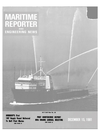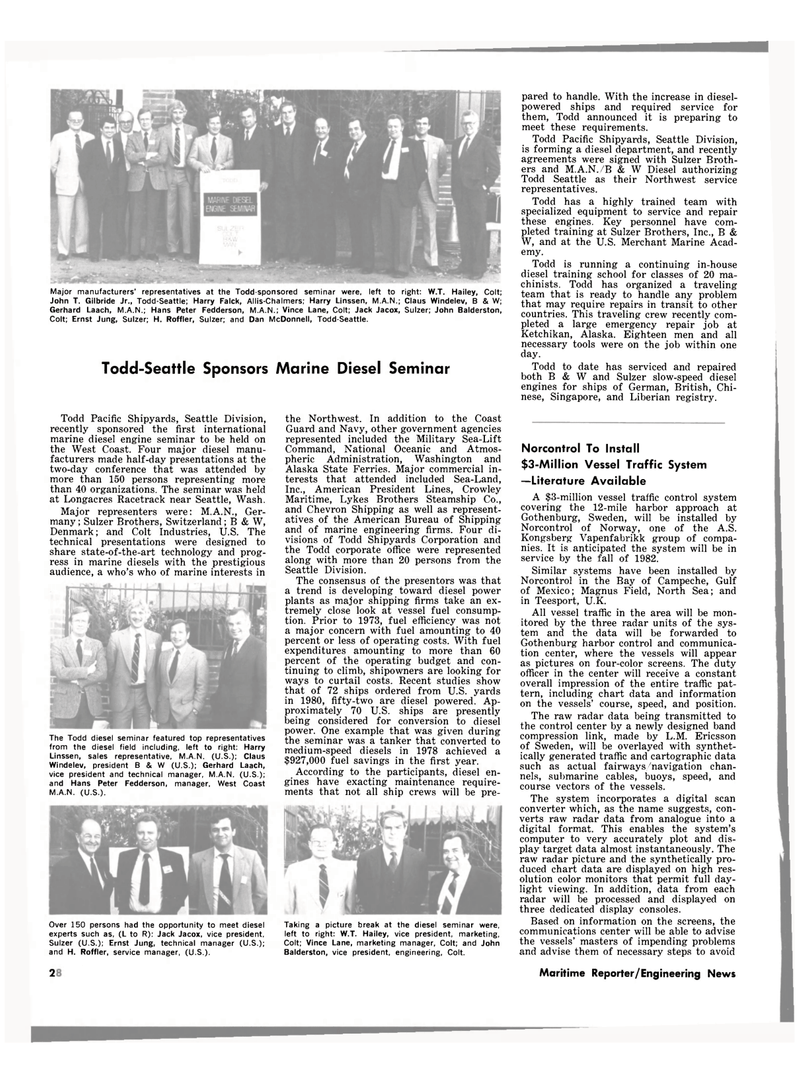
Page 24: of Maritime Reporter Magazine (December 15, 1981)
Read this page in Pdf, Flash or Html5 edition of December 15, 1981 Maritime Reporter Magazine
Major manufacturers' representatives at the Todd-sponsored seminar were, left to right: W.T. Hailey, Colt;
John T. Gilbride Jr., Todd-Seattle; Harry Falck, Allis-Chalmers; Harry Linssen, M.A.N.; Claus Windelev, B & W;
Gerhard Laach, M.A.N.; Hans Peter Fedderson, M.A.N.; Vince Lane, Colt; Jack Jacox, Sulzer; John Balderston,
Colt; Ernst Jung, Sulzer; H. Roffler, Sulzer; and Dan McDonnell, Todd-Seattle.
Todd-Seattle Sponsors Marine Diesel Seminar
Todd Pacific Shipyards, Seattle Division, recently sponsored the first international marine diesel engine seminar to be held on the West Coast. Four major diesel manu- facturers made half-day presentations at the two-day conference that was attended by more than 150 persons representing more than 40 organizations. The seminar was held at Longacres Racetrack near Seattle, Wash.
Major representers were: M.A.N., Ger- many ; Sulzer Brothers, Switzerland; B & W,
Denmark; and Colt Industries, U.S. The technical presentations were designed to share state-of-the-art technology and prog- ress in marine diesels with the prestigious audience, a who's who of marine interests in
The Todd diesel seminar featured top representatives from the diesel field including, left to right: Harry
Linssen, sales representative, M.A.N. (U.S.); Claus
Windelev, president B & W (U.S.); Gerhard Laach, vice president and technical manager, M.A.N. (U.S.); and Hans Peter Fedderson, manager, West Coast
M.A.N. (U.S.).
Over 150 persons had the opportunity to meet diesel experts such as, (L to R): Jack Jacox, vice president,
Sulzer (U.S.); Ernst Jung, technical manager (U.S.); and H. Roffler, service manager, (U.S.). the Northwest. In addition to the Coast
Guard and Navy, other government agencies represented included the Military Sea-Lift
Command, National Oceanic and Atmos- pheric Administration, Washington and
Alaska State Ferries. Major commercial in- terests that attended included Sea-Land,
Inc., American President Lines, Crowley
Maritime, Lykes Brothers Steamship Co., and Chevron Shipping as well as represent- atives of the American Bureau of Shipping and of marine engineering firms. Four di- visions of Todd Shipyards Corporation and the Todd corporate office were represented along with more than 20 persons from the
Seattle Division.
The consensus of the presenters was that a trend is developing toward diesel power plants as major shipping firms take an ex- tremely close look at vessel fuel consump- tion. Prior to 1973, fuel efficiency was not a major concern with fuel amounting to 40 percent or less of operating costs. With fuel expenditures amounting to more than 60 percent of the operating budget and con- tinuing to climb, shipowners are looking for ways to curtail costs. Recent studies show that of 72 ships ordered from U.S. yards in 1980, fifty-two are diesel powered. Ap- proximately 70 U.S. ships are presently being considered for conversion to diesel power. One example that was given during the seminar was a tanker that converted to medium-speed diesels in 1978 achieved a $927,000 fuel savings in the first year.
According to the participants, diesel en- gines have exacting maintenance require- ments that not all ship crews will be pre-
Taking a picture break at the diesel seminar were, left to right: W.T. Hailey, vice president, marketing,
Colt; Vince Lane, marketing manager, Colt; and John
Balderston, vice president, engineering, Colt. pared to handle. With the increase in diesel- powered ships and required service for them, Todd announced it is preparing to meet these requirements.
Todd Pacific Shipyards, Seattle Division, is forming a diesel department, and recently agreements were signed with Sulzer Broth- ers and M.A.N./B & W Diesel authorizing
Todd Seattle as their Northwest service representatives.
Todd has a highly trained team with specialized equipment to service and repair these engines. Key personnel have com- pleted training at Sulzer Brothers, Inc., B &
W, and at the U.S. Merchant Marine Acad- emy.
Todd is running a continuing in-house diesel training school for classes of 20 ma- chinists. Todd has organized a traveling team that is ready to handle any problem that may require repairs in transit to other countries. This traveling crew recently com- pleted a large emergency repair job at
Ketchikan, Alaska. Eighteen men and all necessary tools were on the job within one day.
Todd to date has serviced and repaired both B & W and Sulzer slow-speed diesel engines for ships of German, British, Chi- nese, Singapore, and Liberian registry.
Norcontrol To Install $3-Million Vessel Traffic System —Literature Available
A $3-million vessel traffic control system covering the 12-mile harbor approach at
Gothenburg, Sweden, will be installed by
Norcontrol of Norway, one of the A.S.
Kongsberg Vapenfabrikk group of compa- nies. It is anticipated the system will be in service by the fall of 1982.
Similar systems have been installed by
Norcontrol in the Bay of Campeche, Gulf of Mexico; Magnus Field, North Sea; and in Teesport, U.K.
All vessel traffic in the area will be mon- itored by the three radar units of the sys- tem and the data will be forwarded to
Gothenburg harbor control and communica- tion center, where the vessels will appear as pictures on four-color screens. The duty officer in the center will receive a constant overall impression of the entire traffic pat- tern, including chart data and information on the vessels' course, speed, and position.
The raw radar data being transmitted to the control center by a newly designed band compression link, made by L.M. Ericsson of Sweden, will be overlayed with synthet- ically generated traffic and cartographic data such as actual fairways/navigation chan- nels, submarine cables, buoys, speed, and course vectors of the vessels.
The system incorporates a digital scan converter which, as the name suggests, con- verts raw radar data from analogue into a digital format. This enables the system's computer to very accurately plot and dis- play target data almost instantaneously. The raw radar picture and the synthetically pro- duced chart data are displayed on high res- olution color monitors that permit full day- light viewing. In addition, data from each radar will be processed and displayed on three dedicated display consoles.
Based on information on the screens, the communications center will be able to advise the vessels' masters of impending problems and advise them of necessary steps to avoid 22 Maritime Reporter/Engineering News

 23
23

 25
25
